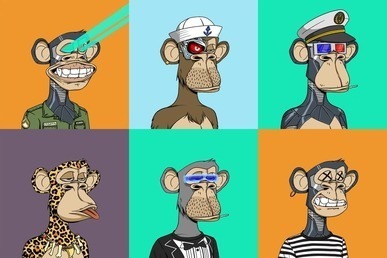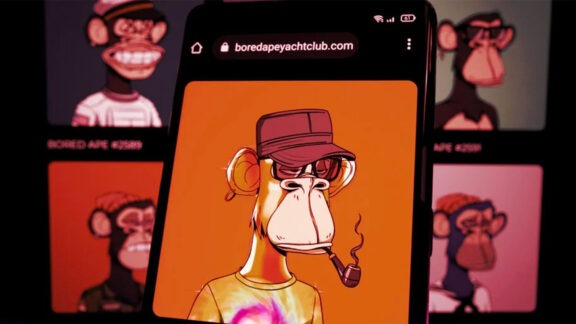In case you missed it, we’ve been talking about the impact of the metaverse on brands and marketing. This time, we consider a different element of the next stage of the digital revolution – Web3 and NFTs. We’ll be explaining what they are and what they mean for brands and businesses.
What is Web3?
The Bennett Institute for Public Policy at the University of Cambridge has helpfully defined Web3 as “the putative next generation of the web’s technical, legal, and payments infrastructure – including blockchain, smart contracts and cryptocurrencies.”
Web3 is an idea for a new version of the world wide web which will incorporate three co-dependent concepts:
- Decentralisation – whereby the traditional internet is redesigned and repurposed to remove centralised data storage. This applies to how companies and websites can currently hold onto your personal information (name, email address, personal information, contact details) and require it for you to engage with their platform. This was the basis on which Web 2.0 was built; with Web3, the concept in theory is that your personal data remains in your hands and cannot be used by other companies for profit. Web3 is intended to be built on blockchain protocols (see below).
- Blockchain technology – the blockchain is a public or private decentralised ledger of all transactions across a peer-to-peer network (which is what Web3 will be). Each ‘block’ in the chain contains a scrambled copy (known as a ‘cryptographic hash’) of the block before it, a timestamp, and transaction data which will establish ownership and conduct transactions. A current example of blockchain usage is the transaction ledger for cryptocurrencies.
- Token-based economics – financial transactions will use cryptocurrencies such as Bitcoin and Ethereum, and the products and benefits purchased will be distributed as NFTs (non-fungible tokens, see below) which are stored on a public blockchain where ownership can be verified.
In essence, Web3 will be a collection of products and services built on top of the traditional internet structure. These will allow you to buy and sell digital tokens and services and retain full ownership, allowing you to buy, sell or trade them yourself.
What are NFTs?
An NFT, or non-fungible token, is something which is (a) unique and (b) in digital form. It may have begun life as digital, or may have since been digitised. An NFT might be a work of art, or music, or video, for example. Anything digital can be sold as an NFT.
‘Fungible’ means ‘replaceable with another of the same type’, so these tokens can’t be replaced by anything else. For example, a unique work of art can’t be replaced, but a Bitcoin can be swapped for another Bitcoin, so cryptocurrency isn’t an NFT.
In December 2021, Nike acquired RTFKT (pronounced ‘Artefact’), a company which produces virtual trainer designs that can be bought by using the cryptocurrency Ethereum and stored in an online ‘wallet’. Each purchase has an individual code that is verified using blockchain technology, which means that it’s a unique purchase. Think of it as a receipt, or proof of purchase.

As an example from the world of music, the rock band Muse released their latest album as a limited-edition run of 1,000 NFTs. Users who pay £20 will receive the full album in lossless audio, along with digital signatures of the band.
NFTs can also give buyers access to additional memberships and awards. For example, Bored Ape is a collection of NFTs which come with access to the Bored Ape Yacht Club, their membership portal. This offers events and a thriving online community. Owners include celebrities such as Eminem, Madonna and Snoop Dogg.

Every NFT is unique, and ownership can be verified on the blockchain. In other words, everybody can see who owns what. You can also sell your NFT to others and use it across various Web3 platforms. This represents a new frontier for businesses and individuals who are engaged in creativity. You can even use your purchased NFT in your own creative endeavours. Once you own it, it’s yours to do with as you wish. The best example of this is Eminem and Snoop Dogg performing in a live mixed media performance at the MTV VMAs as their respective Bored Ape NFTs.

The concept of portable online ownership
The concept of portability is woven into Web3. For example, if you purchase a pair of trainers from RTFTK, your avatar will be able to wear those trainers anywhere you appear within the metaverse. You could wear them in your Horizon Workrooms meeting with your customers, and then again later while blasting away with your mates in Fortnite.
Artwork is already being traded in this way. Artists are now creating one-off pieces of NFT art that can be bought, used or displayed in whatever way the buyer sees fit. An interesting example is the NFT ‘avatar’; Sotheby’s regularly runs Metaverse auctions where artists offer limited-edition, algorithmically generated profile pictures for purchase online, for use across the metaverse as the buyers’ profile pictures – and, in some cases, their avatars. A profile picture or an avatar may not seem like a status symbol in the world of Facebook and Instagram, but within collector circles they are significant.
How is this important for brands?
Whilst Web3, the blockchain and NFTs may for now seem like the domain of big business and the hyper-rich (after all, a Bored Ape NFT will currently cost you north of £111,000), there is potential for brands to leverage all this.
Creating an NFT that can be used to gain access to products and services across platforms, and selling it to customers in a branded package, would allow you to go beyond simply selling a product, event, or service, and allow you to wrap the whole process up into a branded package.
For example, if you were to sell a ticket to a music concert as an NFT, you could receive not only a ticket to the event, but access to experiences related to it, including a live recording of the concert, a limited, numbered digital signature of the artist, access to an exclusive fan club of fellow fans who also purchased this NFT, and the opportunity to build an ongoing community experience around a single purchase.
It does sound complex and difficult to navigate. And it’s still something of a jungle out there, with high levels of fraud and wildly fluctuating prices. But once the technology settles, we predict that there will be some very interesting use cases coming from the B2B sector, too.
Here at Studio North, we’re always thinking about how your brand will evolve over time – wherever it is. Speak to us today to prepare yourself for tomorrow.








